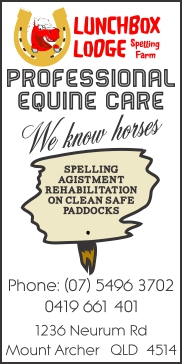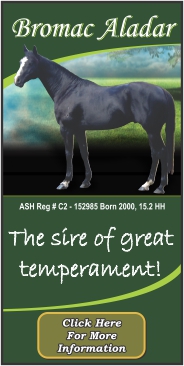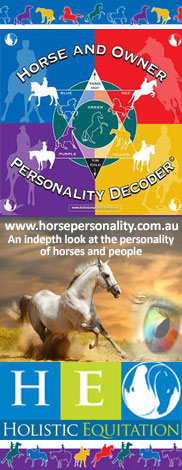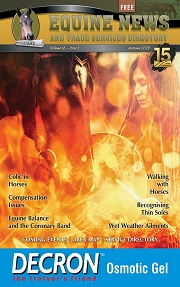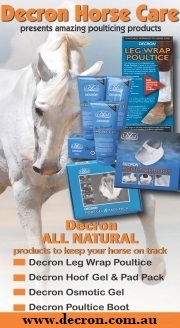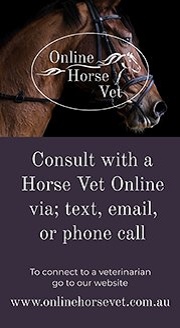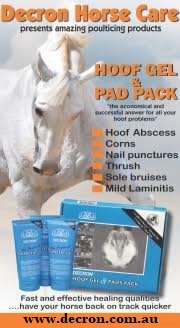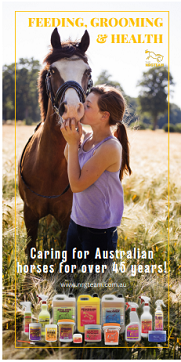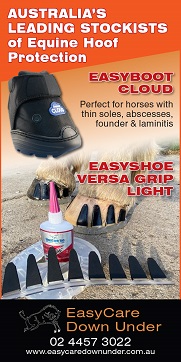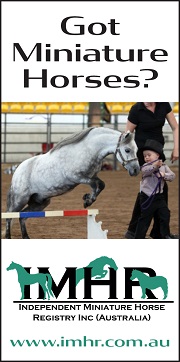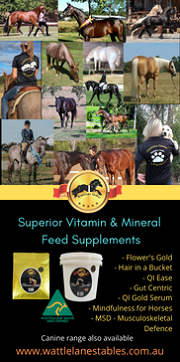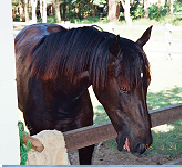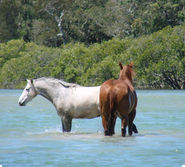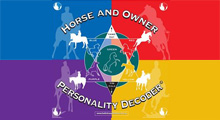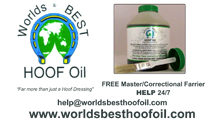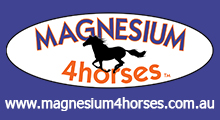Sarah Robinson
Regional Animal Health Leader, Animal and Plant Biosecurity, Wagga Wagga
Strangles, caused by the bacterium Streptococcus equi equi, is one of the most important horse diseases in NSW. It is a notifiable disease which means that if your horse has strangles you have a legal obligation to report it (see ‘What is the best way to notify’ on page 3).
Strangles is usually seen in young horses but it can infect older horses. Outbreaks sometimes occur when large numbers of horses are held in close contact.
Strangles affects the upper respiratory system and lymph nodes of the head. It rapidly spreads from horse to horse through coughing, or by eating feed or drinking water that has been contaminated by a sick horse. Contaminated grooming utensils, rugs, feed bins, or humans (hands, clothing, etc.) can also spread the infection.
Within 3 to 8 days of becoming infected the horse will become depressed and develop a fever (39.5° to 40.5°C). The throat becomes extremely inflamed so that swallowing food or water becomes very painful or impossible. The lymph nodes of the head (particularly in the throat area) become swollen and very painful and may eventually burst and discharge thick creamy yellow pus. This swelling can make breathing difficult. There is often a watery to thick nasal discharge. The horse may develop a cough.
Clinical signs may persist for days to months. In most cases, once affected lymph nodes have abscessed and drained, recovery is uneventful. Abscesses typically rupture and drain within two weeks. Affected horses remain infectious for at least four weeks after clinical signs have disappeared. Some horses may spread the disease for up to eight months after infection, even though they appear healthy.
Occasionally the infection may spread to other parts of the body. This is known as ‘bastard strangles’. This form is difficult and sometimes impossible to cure.
Diagnosis
Horse with strangles – note the swollen lymph nodes in the throat area. Photo from OLIVER, University of Sydney.
Strangles is suspected based on clinical signs. Usually the veterinarian will collect swab samples from the nose and/or any abscesses and send them to a veterinary laboratory for bacterial culture. Growth of S. equi equi confirms the diagnosis.
Treatment and horse welfare
Veterinary treatment should be sought immediately to control the infection, alleviate the symptoms and prevent secondary complications. Horses affected with strangles need good nursing care under veterinary advice.
Horses with strangles should not be transported unless it is absolutely necessary for veterinary treatment. Transport is stressful for sick horses and risks spreading the disease.
Any horse with signs of respiratory disease, such as a ‘snotty’ nasal discharge, should not be taken to any place where it might come into contact with other horses, e.g. sale yards, showgrounds, pony club, race meetings.
Preventing spread to other horses on your property
Affected horses should be isolated for 6 to 8 weeks following the onset of clinical signs to prevent spread to other horses.
Strict hygiene is necessary for people handling horses. For example, handlers of infected horses should avoid going near uninfected horses. Scrupulous hand and boot washing and the use of disposable over-clothing are recommended. Any gear, such as rugs, halters, lead ropes, feed bins, and grooming brushes, should also be kept separate and used only for the sick horse. It should then be disinfected after the sick horse has recovered and before being used on other horses.
Reducing the risk of introducing strangles to your property
Most diseases are introduced to a horse property with the arrival of a new horse that is already infected, even though it might not be showing clinical signs.
Alternatively, your horse property might become infected if one of your horses comes into contact with an infected horse at an event, and then brings the infection home.
Handling new arrivals
It is a good idea to ask what vaccinations or medications have been given to any horse you are planning to introduce to your property. Find out if there has been any recent illness among horses on the property of origin and get as many details as possible. A pre-purchase examination by a veterinarian is always helpful. Isolate new arrivals from resident horses for at least two weeks and check them daily for any signs of ill health.
Protection when attending events
When you take your horse to competitions or events, make it standard practice to take along your own feed bins, water buckets, tack and grooming gear. There is always a risk of infection if you share equipment or let your horse use communal water troughs or feeders.
Thoroughly clean your boots and outer clothing after each horse event.
Where possible, it is advisable to keep your competition horses separate from your ‘stay at home’ horses, and to keep records of horse movements. These records help with tracing in the event of a disease outbreak.
Visiting horse properties
People can introduce diseases if they handle an infected horse and then handle another horse soon afterwards.
If you have been in contact with other horses you need to thoroughly wash your hands before handling your own horses. You should also consider changing your clothes. Check that visitors to your property follow the same biosecurity precautions.
Boundary fences
Nose-to-nose contact between your horses and those on a neighbouring property may allow an infectious disease to spread. This risk can be managed by keeping horses away from the boundary or using double fencing. A line of trees between the fences is ideal both as a windbreak and to improve biosecurity.
Vaccination
A regular vaccination program to help prevent strangles is recommended for horses that go to studs, shows or camps, or those on agistment with other horses. Vaccination cannot provide 100% protection but it will reduce the incidence and severity of disease. Strangles vaccine can be given alone or combined with tetanus vaccine as a bivalent (2-in-1) vaccine.
In previously vaccinated mares a booster 2 to 6 weeks before foaling will provide protection for her foal via the milk. This protection will last for approximately 12 weeks. Foals should then be started on their own vaccination program at 12 weeks of age and given 3 doses at 2 week intervals.
Annual boosters are necessary to maintain adequate levels of immunity. Six-monthly boosters are recommended to provide increased protection in high risk situations.
Swelling at the site of injection and some mild systemic signs (e.g. depression and inappetence) may occur following vaccination.
Why is strangles notifiable?
Under the NSW Stock Diseases Act 1923 it is a legal requirement to report cases of strangles. This requirement is necessary so that horse exports and international horse movements can continue.
Many countries to which we export horses require certification that the property of origin has been free from strangles for at least three months (some require certification of freedom from disease for up to two years) prior to export.
Notification must be made by horse owners, people who own land where horses are kept, veterinarians, veterinary pathologists and any other person consulted about a horse’s illness.
Details required include the date on which the disease was first suspected or confirmed, the horse’s identification details, the owner’s name and the address of the property where the horse is located.
What is the best way to notify?
The best way to notify a suspected or confirmed case of strangles is by phoning the NSW DPI horse health coordinator on (02) 6938 1967. You can also notify by phoning or calling in at any NSW DPI office or at a Livestock Health and Pest Authority office (formerly known as Rural Lands Protection Board).
Alternatively, you can fill in the NSW notifiable animal disease form, fax it to (02) 6361 9976, or email it to: biosecurity@dpi.nsw.gov.au
How is the information used?
All information is handled confidentially. The information is primarily used for export certification purposes. The information may also be used, in a manner ensuring confidentiality, to warn other horse owners to take precautions to prevent strangles infection when an outbreak of strangles has been identified. No government regulatory action, such as property quarantine, is applicable to strangles but owners are encouraged to discuss management precautions with their veterinarian to prevent spread of infection.
For further information contact Sarah Robinson, NSW DPI horse health coordinator. Ph (02) 6938 1967.
© State of New South Wales through NSW Department of Primary Industries 2009. You may copy, distribute and otherwise freely deal with this publication for any purpose, provided that you attribute NSW Department of Primary Industries as the owner.
ISSN 1832-6668
Check for updates of this Primefact at: www.dpi.nsw.gov.au/primefacts
Disclaimer: The information contained in this publication is based on knowledge and understanding at the time of writing (January 2009). However, because of advances in knowledge, users are reminded of the need to ensure that information upon which they rely is up to date and to check currency of the information with the appropriate officer of New South Wales Department of Primary Industries or the user’s independent adviser.
Job number 9208









